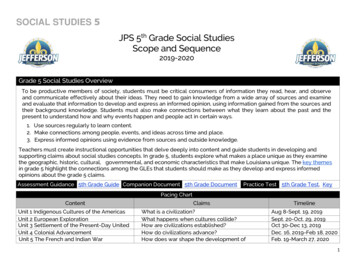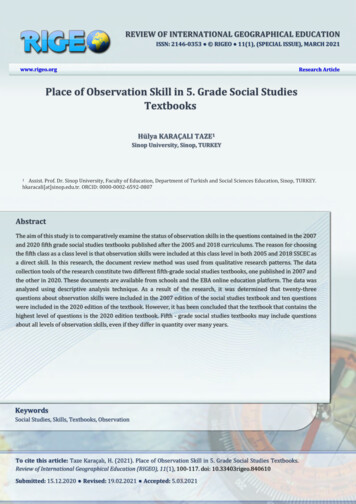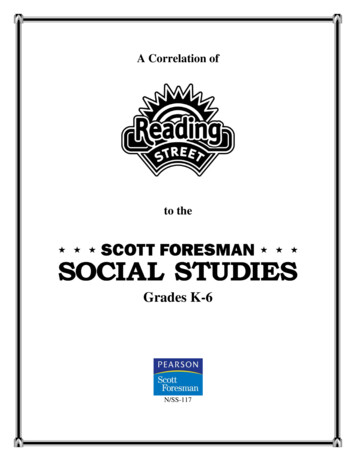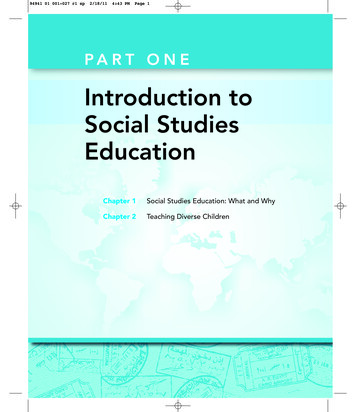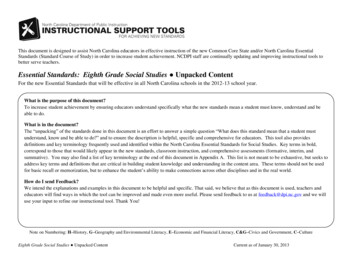
Transcription
This document is designed to assist North Carolina educators in effective instruction of the new Common Core State and/or North Carolina EssentialStandards (Standard Course of Study) in order to increase student achievement. NCDPI staff are continually updating and improving instructional tools tobetter serve teachers.Essential Standards: Eighth Grade Social Studies Unpacked ContentFor the new Essential Standards that will be effective in all North Carolina schools in the 2012-13 school year.What is the purpose of this document?To increase student achievement by ensuring educators understand specifically what the new standards mean a student must know, understand and beable to do.What is in the document?The “unpacking” of the standards done in this document is an effort to answer a simple question “What does this standard mean that a student mustunderstand, know and be able to do?” and to ensure the description is helpful, specific and comprehensive for educators. This tool also providesdefinitions and key terminology frequently used and identified within the North Carolina Essential Standards for Social Studies. Key terms in bold,correspond to those that would likely appear in the new standards, classroom instruction, and comprehensive assessments (formative, interim, andsummative). You may also find a list of key terminology at the end of this document in Appendix A. This list is not meant to be exhaustive, but seeks toaddress key terms and definitions that are critical in building student knowledge and understanding in the content area. These terms should not be usedfor basic recall or memorization, but to enhance the student’s ability to make connections across other disciplines and in the real world.How do I send Feedback?We intend the explanations and examples in this document to be helpful and specific. That said, we believe that as this document is used, teachers andeducators will find ways in which the tool can be improved and made even more useful. Please send feedback to us at feedback@dpi.nc.gov and we willuse your input to refine our instructional tool. Thank You!Note on Numbering: H–History, G–Geography and Environmental Literacy, E–Economic and Financial Literacy, C&G–Civics and Government, C–CultureEighth Grade Social Studies Unpacked ContentCurrent as of January 30, 2013
HistoryEssential Standard:8. H.1 Apply historical thinking to understand the creation and development of North Carolina and the United States.Concept(s): Historical Thinking, Historical Narratives, Historical Inquiry, Historical ContextClarifying ObjectivesUnpackingWhat does this standard mean a student will know, understand and be able to do?8.H.1.1 Construct charts, graphs, andhistorical narratives to explainparticular events or issues.The student will understand: Historical events or issues can be understood through the use of data from various sources.The student will know: Examples of how charts, graphs, and historical narratives can be used to explain historicalevents. Various tools used to construct charts and graphs. The process of creating a historical narrative.The student will be able to: Create charts, graphs, and historical narratives to explain events or issues.For example: Create a timeline depicting events leading to the American RevolutionaryWar, during the Revolution, and following the Revolution in order to explain its causes andeffects.Key Terminology: Historical narrative is an account, report or story of events or experiences that is based onfactual evidence from the past.Resources: National Center for History in the Schools (UCLA) – Historical istorical-thinking-standards-1/2.-historicalEighth Grade Social Studies Unpacked ContentPage 2 of 29Current as of January 30, 2013
8.H.1.2 Summarize the literalmeaning of historical documents inorder to establish context.comprehension/?searchterm historical%20narrativeTeaching History.org: “Stories in History: Is Narrative an American esearch/research-brief/23631The student will understand: Understanding the literal meaning of a historical document encourages more accurateconclusions about historical issues and events.The student will know: Examples of historical documents and their associated events or issues. The different types of information primary sources can provide (i.e., photographs may presentinformation related to culture, ledgers may present information related to economics, andmaps may present information related to geography).The student will be able to: Abstract a general theme or point of a historical document by articulating its word for wordmeaning.For example: Summarize the literal and contextual meaning of this quote from TheDeclaration of Independence – “all men are created equal.”Key Terminology: Literal meaning refers to the meaning of a passage, text, etc. as its author intended and whatthe original hearers/readers would have understood.Resources: National Center for History in the Schools (UCLA) – Historical Thinking Standard ical-comprehension#section-0Note: Reconstructing the literal meaning of a historical passage requires one to identify certaincontextual information (i.e. who was involved, what happened, where it happened, what events led toEighth Grade Social Studies Unpacked ContentPage 3 of 29Current as of January 30, 2013
these developments, and what consequences or outcomes followed). Once students are able toestablish the literal meaning of a document, they will be able to apply this meaning to multiplesituations/time periods to establish the context for the use of that document. Additionally, studentswill be able to see if that literal meaning stood the test of time.8.H.1.3 Use primary and secondarysources to interpret various historicalperspectives.The student will understand: Interpreting multiple historical perspectives is necessary to understanding the past. The credibility of historical sources must be examined in order to ensure accuracy andappropriateness.The student will know: The difference between a primary and a secondary source. How to differentiate between the value of primary and secondary sources. Examples of primary and secondary sources. Where to find credible sources of information. Appropriate questions to ask in order to interpret various historical perspectives.The student will be able to: Use different sources of information (both primary and secondary) from multiple perspectives(e.g., race/ethnic groups, gender, socioeconomic status, political affiliation, time periods) tounderstand and interpret a particular event or issue. Analyze various primary source documents.For example: Read a textbook account and primary source documents from multipleperspectives about the Vietnam War (letters from soldiers, U.S. Presidents speeches, oralhistories from the North and South Vietnamese).Eighth Grade Social Studies Unpacked ContentPage 4 of 29Current as of January 30, 2013
Key Terminology: Primary sources provide a first-hand account or direct evidence concerning a topic underinvestigation. They are created by witnesses or recorders who actually experienced the eventsor conditions being documented. While these sources are often created at the time when theevents or conditions are occurring, primary sources may also include autobiographies,memoirs, and oral histories recorded later. (Yale University, see resource link below)Examples include: photographs, letters, diaries, artifacts, music and songs, broadsides,poetry, charts/graphs, census records & other governmental documents, audio recordings,architectural landmarks, etc. Secondary sources provide interpretations of primary sources. Examples include: textbooks, magazine and journal articles, Historical perspective the ability to describe the past from the point of view of those wholived during the particular time period under study.Resources: Primary Sources at Yale University:http://www.yale.edu/collections collaborative/primarysources/primarysources.html Primary Source: Educating for Global Understanding: ce Distinguish Between Primary and Secondary uish-between-primary-and-secondary-sources Using Primary Sources – Library of ources/ National Center for History in the Schools (UCLA) – Historical hension/?searchterm historical%20perspective The Historical Thinking Project: Promoting Critical Historical Literacy for the 21st rical-perspectivesNote: Acquiring a historical perspective requires one to (a) study primary sources of the time periodunder study including literature, diaries, letters, debates, arts, artifacts, etc.; (b) considering thehistorical context in which the event unfolded--the values, outlook, options, and contingencies of thatEighth Grade Social Studies Unpacked ContentPage 5 of 29Current as of January 30, 2013
time and place; and (c) avoid "present-mindedness," judging the past solely in terms of present-daynorms and values. (See the National Center for History in the Schools UCLA site listed in thereferences above).8.H.1.4 Use historical inquiry toevaluate the validity of sources used toconstruct historical narratives (e.g.formulate historical questions, gatherdata from a variety of sources,evaluate and interpret data and supportinterpretations with historicalevidence).The student will understand: Historical inquiry is a key component to understanding the past. The credibility of historical sources must be examined in order to ensure accuracy andappropriateness.The student will know: Historical inquiry is the research or investigation of past events. Historical inquiry seeks to answer the provocative questions. Where to find credible sources of information. A set of criteria for determining whether or not a source is valid. Appropriate questions to ask in order to interpret various historical perspectives.The student will be able to: Use a set of criteria to gauge the value of a source. Formulate historical provocative and conceptual questions. Gather data from a variety of sources (both primary and secondary). Interpret data in a historical context. Support interpretations with historical evidence. Assess interpretations of history and determine how valuable each interpretation is to thereader.Eighth Grade Social Studies Unpacked ContentPage 6 of 29Current as of January 30, 2013
Determine bias and perspective in a historical source.Key Terminology: Historical inquiry is a cyclical process of historical thinking that begins with the asking ofone or more guiding historical questions. The answers to these questions are explored bylocating and analyzing primary and secondary historical sources. This historical evidence is,in turn, used to construct historical narratives/interpretations about the past that seek toprovide answers to the guiding historical questions. The process begins again because theseinterpretations often lead to the development of other historical questions that need to beexplored. Historical thinking is a complex set of processes that historians use in order to analyzeevents in the past. These processes include the reading, analysis, and writing that isnecessary to develop an accurate understanding of historical events and situations so thathistorians can construct narratives that are as accurate as possible. Engaging in this complexprocess is known as historical inquiry. Components of historical thinking:o Multiple Accounts & Perspectiveso Analysis of Primary Documents: What was the sources origin?o Understanding Historical Contexto Historical arguments and stories that are backed by evidence. Historical evidence is a primary artifact used to support a historical point of view orperspective.Resources: Teaching History.org: “What is Historical Thinking” http://teachinghistory.org/nhecblog/24434 Video: “Why Historical Thinking Matters” http://historicalthinkingmatters.org/why.html Historical Inquiry: http://www.historicalinquiry.com/inquiry/index.cfm The Historical Thinking Project: Promoting Critical Historical Literacy for the 21st Century:http://historicalthinking.ca/Eighth Grade Social Studies Unpacked ContentPage 7 of 29Current as of January 30, 2013
8.H.1.5 Analyze the relationshipbetween historical context anddecision-making.Teaching History.org: “What is an Inquiry Lesson?” ing-guides/24123Teaching History.org: “Uncoverage’ in History Survey esearch/research-brief/23476History Matters: The U.S. Survey Course on the Web – “Making Sense of kesense/The student will understand: Decisions that shape the course of history are influenced by the era in which they are made. Social norms and expectations vary from generation to generation and need to be taken intoaccount when studying history.The student will know: How to determine a time period’s historical context. Examples of how historical context impacts decisions about historical events.(e.g., dropping the atomic bomb, Emancipation Proclamation, the declaration of WWI)The student will be able to: Identify issues and problems in a particular time and analyze the interests, values,perspectives, and points of view of those involved in the situation in order to establishcontext.Eighth Grade Social Studies Unpacked Content Provide evidence from past events and circumstances that may have been contributingfactors to contemporary problems and alternative courses of action. Evaluate alternative courses of action, keeping in mind the information available at the time,in terms of ethical considerations, the interests of those affected by the decision, and thelong- and short-term consequences of each. Formulate a position or course of action on an issue by identifying the nature of the problem,analyzing the underlying factors contributing to the problem, and choosing a plausiblePage 8 of 29Current as of January 30, 2013
solution from a choice of carefully evaluated options. Evaluate the implementation of a decision by analyzing the interests it served througho estimating the position, power, and priority of each player involved.o assessing the ethical dimensions of the decision.o evaluating its costs and benefits from a variety of perspectives.Key Terminology: Historical context is the “setting” for events or the conditions in which the events occurred.Refers to the moods, attitudes, and conditions that existed in a certain time period.Resources: National Center for History in the Schools (UCLA) – al-thinking-standards-1/5.-historical-issuesNote: An understanding of context is vitally important to history because it adds relevancy to anevent or artifact under analysis.Eighth Grade Social Studies Unpacked ContentPage 9 of 29Current as of January 30, 2013
Essential Standard:8.H.2 Understand the ways in which conflict, compromise and negotiation have shaped North Carolina and the United States.Concept(s): Conflict, Compromise, Negotiation, Leadership, Civic Action, Debate, Cooperation, RegionsClarifying Objectives8.H.2.1 Explain the impact ofeconomic, political, social, and militaryconflicts (e.g. war, slavery, states’rights, and citizenship and immigrationpolicies) on the development of NorthCarolina and the United States.UnpackingWhat does this standard mean a student will know, understand and be able to do?The student will understand: Conflict most often results in societal change. Conflict and compromise often vary based on economic, political, social, and military goals. The implications of national and global conflicts may vary for all stakeholders involved.The student will know: North Carolina’s role in selected local, state, national, and global conflicts. The role and implications of the United States’ involvement in or isolation from globalconflicts and the reasons for involvement or isolation.For example: Understand the impact the Great Depression had on various groups withinNorth Carolina and the United States.For example: The impact Jim Crow laws had on various populations and regions such assegregated housing and access to resources, and the demographic make-up of towns, cities,states and regions due to migration patterns.Note: The study of conflicts is not limited to military conflicts, but should include conflicting ideasthat stem from economic, political, and social ideologies.8.H.2.2 Summarize how leadershipand citizen actions (e.g. the foundingfathers, the Regulators, the GreensboroFour, and participants of theEighth Grade Social Studies Unpacked ContentThe student will understand: Leadership and citizen actions can drive the outcome of conflicts.Page 10 of 29Current as of January 30, 2013
Wilmington Race Riots, 1898)influenced the outcome of key conflictsin North Carolina and the UnitedStates. Citizen action is sometimes contrary to established laws and the ideas of leadership. Citizens play a key role in the governance of democratic societies.The student will know: Various types of leadership (e.g., proprietors, governors, presidents and other heads of state,legislators and other government officials, business and community leaders, citizens). How different types of citizen action influenced the outcome of conflicts (e.g., boycott,protest, letter writing). The ways in which leaders may have influenced the outcome of conflicts (both positively andnegatively) through actions and decision-making such as negotiation, compromise, and dealmaking. 8.H.2.3 Summarize the role of debate,compromise, and negotiation duringsignificant periods in the history ofNorth Carolina and the United States.Examples of leadership and citizen action in North Carolina as compared to the United States(e.g., the Greensboro Four as compared to the national leaders of COREThe student will understand: Democracies depend on debate, compromise, and negotiations to maintain their effectiveness.The student will know: Examples of historical and contemporary economic, political, and cultural debates that havetaken place in North Carolina and the United States.For example: Presidential debates, the debates over slavery, the debates in the NorthCarolina General Assembly and the United States Congress regarding the budget andimmigration laws, economic debates over the benefits of New Deal programs, culturaldebates over fashion changes in various years (1920’s/1950’s) or civil rights debates over theGreensboro sit-ins. Various compromises that have taken place in North Carolina and the United States.For example: United States Constitutional compromises such as the Great Compromise, theThree-Fifths Compromise, the Missouri Compromise, the Compromise of 1877Eighth Grade Social Studies Unpacked ContentPage 11 of 29Current as of January 30, 2013
Various instances of negotiation that have taken place in North Carolina and the UnitedStates.For example: The negotiations in North Carolina that led to the state’s support of the UnitedStates Constitution.Essential Standard:8.H.3 Understand the factors that contribute to change and continuity in North Carolina and the United States.Concept(s): Change, Individuals, Migration, Technology, Innovation, ContinuityClarifying Objectives8.H.3.1 Explain how migration andimmigration contributed to thedevelopment of North Carolina and theUnited States from colonization tocontemporary times (e.g. westwardmovement, African slavery, Trail ofTears, the Great Migration and Ellisand Angel Island).Eighth Grade Social Studies Unpacked ContentUnpackingWhat does this standard mean a student will know, understand and be able to do?The student will understand: Migration and immigration help to shape the development of a state and nation bycontributing new ideas, culture and a workforce. Migration and immigration patterns are often determined by environmental, economic, andsocietal changes.The student will know: Reasons why people immigrate (both forced and voluntary) to the United States. Reasons for migration (both forced and voluntary) within the United States and to and fromNorth Carolina. Changing demographics of North Carolina and the United States as a result of immigration tothe United States and migration within the United States and North Carolina.Page 12 of 29Current as of January 30, 2013
8.H.3.2 Explain how changes broughtabout by technology and otherinnovations affected individuals andgroups in North Carolina and theUnited States (e.g. advancements intransportation, communicationnetworks and business practices).The student will understand: Technology encompasses many different types of innovation. Technology and innovation can lead to societal changes and economic growth, andpotentially impact groups differently.The student will know: Examples of technological advances in United States and North Carolina history (e.g., cottongin, Intracoastal Waterway, railroads, Wright Brothers’ airplane, Research Triangle Park,Dismal Swamp Canal, computers and the Internet). How various innovations evolved and their impact, both positive and negative, on individualsand groups in regions of North Carolina and the United States.Key Terminology: Innovation refers to the creation and implementation of new ideas, methods or devices. 8.H.3.3 Explain how individuals andgroups have influenced economic,political and social change in NorthCarolina and the United States.Technology is defined as the application of scientific knowledge for practical purposes.The student will understand: Individuals and groups motivated by economic, political, or social grievances can bepowerful forces for societal change.The student will know: The beliefs, feelings and actions of individual people who affected change in North Carolinaand the United States.For example: Cameron Morrison, John White, Penelope Barker, Henry Berry Lowery, EllaBaker, Terry Sanford, Jim Hunt, Jesse Helms, James K. Polk, and other governors,congressional leaders, presidents, civil rights leaders, activists, citizens. Eighth Grade Social Studies Unpacked ContentHow groups were motivated to and have affected change in North Carolina and the UnitedStates.Page 13 of 29Current as of January 30, 2013
8.H.3.4 Compare historical andcontemporary issues to understandcontinuity and change in thedevelopment of North Carolina and theUnited States.For example: The Regulators, Abolitionists, Greensboro Four, the women of the EdentonTea Party.The student will understand: The circumstances surrounding congruent historical and contemporary issues may producevaried outcomes. The stability of or change in a society may be shaped by historical trends.The student will know: The circumstances surrounding particular current events and issues in North Carolina, theUnited States and the world, and how these events mirror and are shaped by past events. History is comprised of reoccurring themes (e.g., state vs. federal rights, liberty vs. justice,the social contract.).Geography and Environmental LiteracyEssential Standard:8.G.1 Understand the geographic factors that influenced North Carolina and the United States.Concept(s): Location, Movement, Region, Physical Characteristics, Human Characteristics, Quality of Life, Settlement PatternsClarifying ObjectivesUnpackingWhat does this standard mean a student will know, understand and be able to do?8.G.1.1 Explain how location andplace have presented opportunities andchallenges for the movement of people,goods, and ideas in North Carolina andthe United States.Eighth Grade Social Studies Unpacked ContentThe student will understand that: The physical characteristics of a place may limit the mobility of people, goods and ideas. Access to transportation and communication networks allows for the movement of people,goods, and ideas. The physical and human characteristics of a place may determine migration, immigration orsettlement patterns.Page 14 of 29Current as of January 30, 2013
The student will know: How to describe the various regions of North Carolina and the United States in terms ofphysical environment (both natural and man-made). How to describe North Carolina and the United States in terms of their location relative toother states and nations. Specific geographic challenges/barriers to the movement of people, goods, and ideas in NorthCarolina (e.g., Appalachian Mountain chain, the Diamond Shoals). Specific geographic challenges/barriers to the movement of people, goods, and ideas in theUnited States (e.g., mountain ranges, weather, and waterways). 8.G.1.2 Understand the human andphysical characteristics of regions inNorth Carolina and the United States(e.g. physical features, culture, politicalorganization and ethnic make-up).Policies, practices and laws that limit or impact individuals and/or groups from immigratingto North Carolina and/or the United States or migrating within North Carolina and/or theUnited States (e.g., Fugitive Slave Act, Indian Removal Act, Chinese Exclusion Act,immigration quotas).The student will understand: Geographic regions differ according to distinct unifying characteristics such as physical,cultural, political, economic and ethnic features. Regional designations may change over time. The rate of change in a region depends on its geographic location and its human and physicalcharacteristics.The student will know: The various types of regions (such as geographic, economic, political, or cultural).Eighth Grade Social Studies Unpacked Content The unifying characteristics that define a particular region in North Carolina and the UnitedStates. How and why regions may change.Page 15 of 29Current as of January 30, 2013
Specific examples of geographic, cultural, political, economic and ethnic regions.8.G.1.3 Explain how human andThe student will understand:environmental interaction affected Human and natural disasters may cause a population of people, wildlife, and resources to bequality of life and settlement patterns indisplaced.North Carolina and the United States(e.g. environmental disasters, Natural and human disasters can dictate settlement patterns of places.infrastructure development, coastalrestoration and alternative sources of Humans may modify the environment in a way that improve the quality of life throughenergy).economic growth or environmental development that results in increased human comfort. Human modification of the environment may lead to intended and unintended negativeconsequences.The student will know: Various ways North Carolinians have adapted to and modified the environment and thecorresponding outcomes of those adaptations and modifications. Various ways in which the environment of the United States has been changed to meet theneeds of the people and the corresponding outcomes. Various ways in which nature has impacted the quality of life and settlement patterns inNorth Carolina and the United States.Key Terminology: Quality of life (QOL) can be broadly defined as socio-economic wellbeing and lifesatisfaction and is a subjective measure, but can be quantified, to some extent, by using aquality-of-life index or other tool. Standard indicators of quality of life include: materialwellbeing (GDP), health, political stability and security, family life, community life, climateand geography, job security, political freedom, and gender equality.References: Economists: “The Economist Intelligence Unit’s quality-of-life index”http://www.economist.com/media/pdf/QUALITY OF LIFE.pdfEighth Grade Social Studies Unpacked ContentPage 16 of 29Current as of January 30, 2013
Investopedia: e.asp#axzz1nXvuJZ6GNote: Quality o f life should not be confused with standard of living. Standard of living is the levelof wealth, comfort, material goods, and necessities available to a particular socio-economic class ina particular geographic area/region. (see ing.asp#axzz1nXvuJZ6G for additional information about standard of living.)Economics and Financial LiteracyEssential Standard:8.E.1 Understand the economic activities of North Carolina and the United States.Concept(s): Resources, Conflict, Cooperation, Competition, Growth, Decline, Stability, Choice, Quality of LifeClarifying ObjectivesUnpackingWhat does this standard mean a student will know, understand and be able to do?8.E.1.1 Explain how conflict,cooperation, and competitioninfluenced periods of economic growthand decline (e.g. economic depressionsand recessions).The student will understand: Competition for scarce resources can lead to conflict in society. Cooperation and collaboration among citizens during periods of economic decline may leadto economic growth and stability. Overuse of scarce resources may lead to economic instability, recession or depression. Lack of agreement on economic goals of a nation leads to internal and external conflict.The student will know: The various times North Carolina and the United States have experienced periods ofeconomic growth and decline (e.g., the Rip Van Winkle years in North Carolina, theeconomic boom of the 1920s, the Great Depression, North Carolina and California GoldRushes).Eighth Grade Social Studies Unpacked ContentPage 17 of 29Current as of January 30, 2013
8.E.1.2 Use economic indicators (e.g.GDP, inflation and unemployment) toevaluate the growth and stability of theeconomy of North Carolina and theUnited States. How people competed for scarc
Eighth Grade Social Studies Unpacked Content Page 2 of 29 Current as of January 30, 2013 History Essential Standard: 8. H.1 Apply historical thinking to understand the creation




